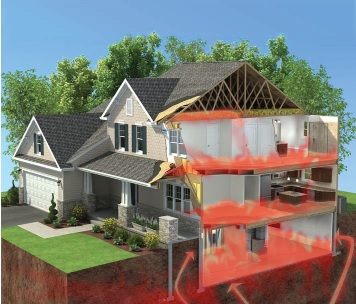Radon is the number two cause of lung cancer. It is a very dangerous gas and when exposed to high levels of it, can cause health risks to both you and your family. Did you know that the EPA estimates that around 11% of all lung cancer deaths each year are caused by Radon exposure in the U.S.?
Where does Radon come from? Radon is a naturally occurring radioactive gas and comes from the natural breakdown of uranium. It is usually found in igneous rock (such as granite) and soil. Radon can also be found in water. When Radon enters into outside air, it dissipates, but when it enters into an enclosed area, like a basement, it accumulates.
How does Radon get into my home? Radon enters in through cracks, concrete pores, and openings. Radon has the highest concentrations in the basement, but gas rises and in Winter months when windows and doors are kept closed, Radon can be found in other levels of the home. The above photo, posted by Dakota Radon Mitigation, shows just how far up Radon gas can travel.
Why neighbor doesn’t have Radon so I am fine, right? Wrong! Your Radon level may be entirely different from your neighbor’s because the soil around your house is different. You should always consider getting a Radon test done even if your neighbor has low Radon.
How to I stop Radon? It is very important to understand that concrete sealers do not stop Radon gas. Period. There is no super sealer that stops the movement of gas through a porous concrete surfaces. While you can reduce the flow of Radon gas through the pores, the reduction will be minimal. You can’t bring a Radon gas reading of 50 pCi/L down to 4 pCi/L with just the use of a sealer. Certain types of sealers, like sodium silicate densifiers, can reduce the flow of Radon through pores, but they won’t be able to stop Radon completely. The only way to get Radon out of your basement is with a Radon mitigation system. Radon mitigation systems will take the Radon gas from inside your home and re-direct it outside where it can dissipate into the air.
What is a Radon mitigation system?
Can I still use a sealer? Ultimately, it is up to the homeowner what they wish to do. Some people who have very low readings choose to just seal their concrete and repair their cracks. They will get a very slight reduction, but in their opinion, that reduction is enough. Other homeowners will choose to seal their concrete, repair cracks, and install a mitigation system. Sealers help to provide piece of mind that larger pores are smaller, and openings are eliminated, which is fine. If you are going to use a sealer, you want to use a sodium silicate densifier because it will fill in the pores with a crystalline barrier that reduces the size of the pores.
Can I use a coating? Non-breathable epoxy coatings can reduce Radon levels more than a sealer, but the EPA still suggests that basement coatings should be used in addition to Radon mitigation systems, NOT in replace of.

